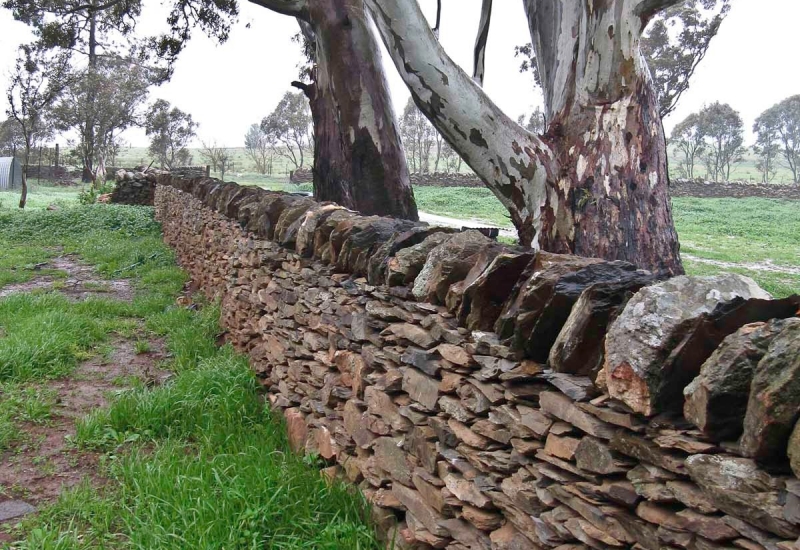Worldwide, stones are a feature of the landscape where the land was formed by volcanic activity. Volcanic plains soil is fertile and human ingenuity has, for centuries, cleared harsh stony landscapes of their stones and fashioned them with great tenacity into walls to mark boundaries, define spaces, contain animals and crops, provide housing and serve as barriers against predators and the elements.
Great skill evolved so structures that were strong and durable could be built with only the stones to hand and simple manual tools. As with all finely crafted objects, dry stone walls are beautiful as well as useful, settling naturally into gently undulating landscapes, offering shelter from sun and wind and habitat for small animals and lichen.
In Australia, dry stone walls were arguably the first expression of colonial public art in the landscape; their aesthetic qualities and strong sculptural forms creating visual definitions and picturesque qualities that allude to romantic traces of ruins to the landscape.
The craft of dry stone walling in Australia emerged in the mid-1800s in areas where a proliferation of stone in the geological landscape necessitated a clearing of the land. Built as the most economic form of fencing, specific historical associations can also be made with particular landowners as so often the style of wall also reflects the status of its builder.
However, it was long before European settlement that this ancient craft made its imprint on the Australian landscape. In the parts of Australia where food and stones were abundant, First Nation indigenous people built low, usually circular dry stone structures, some roofed with branches and bark, and elaborate stone traps for fish and eel; the distinctive remains of which still exist at locations such as Lake Condah in south-west Victoria and Brewarrina in NSW.
Well before the arrival of Captain Cook in 1770, the Dutch erected structures in dry stone on West Wallabi island off the coast of Western Australia and the French constructed a garden wall at Recherché Bay in southern Tasmania. Myth has it most of Australia’s walls were built by convicts in the 19thC but history shows it was teams of wallers from England, Scotland, Wales, Ireland, Germany, Italy, Switzerland and possibly China and India who plied their trade to farmers and miners. Australia is fortunate in having many fine examples of dry stone walls that are historically and culturally significant and unusually diverse in form and style.
That said, they tended to be taller (some as high as 2 metres) and thicker and deeper than those elsewhere, perhaps an adaptation to Australia’s expansive open spaces, rabbits or the height of its cattle. They stand in the landscape today as testimony to a time when artisan skills indicated the patterns of early settlement.
Listed below are some of Australia’s significant early dry stone structures of which we are aware.
PRE-EUROPEAN SETTLEMENT
Aboriginal fish traps at Lake Condah (Victoria), Brewarrina (New South Wales), Coorong (South Australia), Oyster Harbour King George Sound (Western Australia)
Stone circle believed to be of Aboriginal origin near Heywood (Victoria)
EUROPEAN DISCOVERY OF AUSTRALIA
West Wallabi Island (WA)
Stone Garden wall Recherche Bay (Tas)
EUROPEAN SETTLEMENT
Chinese Structures: Daylesford Melton Dam 2 (Vic)
Dry stone housing: Yandolt and Walhalla (Vic)
Retaining Walls: Walhalla (Vic); Cut Hill, Victor Harbor (SA); Great North Road (NSW)
Post and wire walls: Melton (Vic); Edithburgh (SA)
Dam Walls: Melton (Vic); Tod Reservoir, Eyre Peninsula (SA)
Consumption Dykes: Camperdown (Vic); New Honiton Road, Edithburgh (SA)
Rabbit Walls: Camperdown (Vic)
Sheep washes: Bessibelle and Melton (Vic)
Sheepfolds: Deloraine (Tas); Gordon (SA)
Ha Ha walls: Werribee Park Mansion (Vic); Carrick Hill (SA)
Pig Pen: private property, Pombomeit (Vic); Emu Bay, Kangaroo Island (SA)

